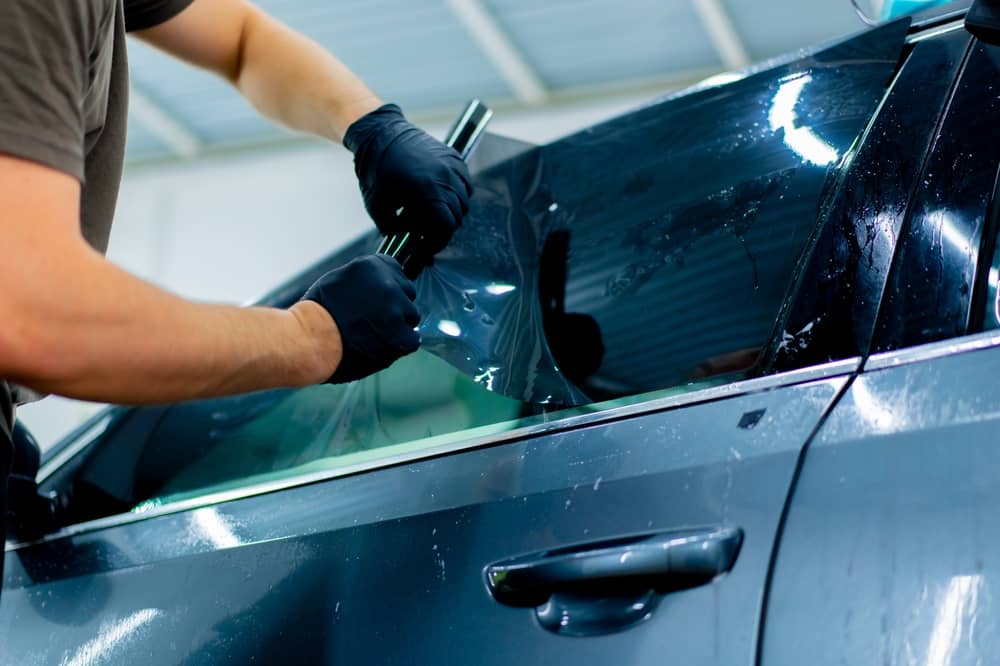Nevada law allows 35% VLT (Visible Light Transmission) on front side windows, any tint on rear and back windows, and non-reflective tint above the AS-1 line on the windshield. Reflectivity must not exceed 35%. Medical exemptions are permitted.
As you drive through the streets of Las Vegas, it’s clear that tinted windows are a popular choice for many drivers.
The intense desert heat makes window tint a practical solution, helping to block out the sun’s rays and keep your car cooler. However, it’s essential to understand the window tint laws in Nevada to avoid fines or other legal issues.
Failure to comply with these laws can result in costly penalties or the need to remove the tint entirely. This article explores everything you need to know about window tint laws in Nevada.

Overview of Window Tint Laws in Nevada
In Nevada, window tint laws are designed to balance protection from the desert sun with safe road visibility.
The Nevada tint law specifies legal tint percentages based on window location and vehicle type to ensure adequate transparency for safe driving. These regulations aim to reduce glare and UV exposure while maintaining clear visibility, crucial for accident prevention. To avoid penalties, it’s important to understand and comply with the legal tint law in Nevada.
By adhering to Nevada window tint laws, you can enjoy a cooler vehicle interior without legal issues.

Allowed Tint Percentages for Different Windows
Nevada tint laws regulate the amount of tint allowed based on Visible Light Transmission (VLT) for each window. The legal tint law in Nevada ensures that drivers maintain visibility while protecting from the sun’s rays.
Here’s a breakdown of the allowed tint percentages:
- Windshield: Tint is allowed only on the top 5 inches, with at least 35% light passing through, ensuring no obstruction to the driver’s view.
- Front Side Windows: Tint must allow at least 35% light through for clear visibility, ensuring safety for both the driver and others.
- Rear Side Windows: These can be tinted as dark as desired, but must still provide adequate visibility, especially at night, and should not obscure rear-view cameras.
- Rear Window: Can be tinted as dark as desired, but must allow clear visibility, particularly in low-light conditions.
By adhering to these Nevada window tint laws, you can avoid penalties and ensure your vehicle remains within legal limits.
Reflection and Tint Color Regulations
In addition to darkness, window tint laws in Nevada also regulate the reflectivity and color of your tint. Reflectivity refers to how much light is bounced off the surface of the glass, helping reduce heat inside the vehicle. While reflective tints are permitted under Nevada tint law, there are strict limits to prevent glare that could pose safety risks on the road.
According to the legal tint law in Nevada, the reflectivity of tinted windows cannot exceed 20%. This limit ensures that excessive glare doesn’t obstruct other drivers’ visibility, especially during low-sun conditions.
Regarding color, Nevada window tint law prohibits red, blue, and yellow tints, as these colors are considered distracting and unsafe. Brightly colored tints could impair vision and create hazardous conditions for both the driver and others on the road. To ensure your tint remains within legal boundaries and is safe, it’s important to adhere to these guidelines.
Exemptions to Nevada Tint Laws
While window tint laws in Nevada generally apply to most vehicles, certain exemptions allow for darker tints under specific circumstances. These exceptions are designed to accommodate individual needs or particular vehicle types. Here are key exemptions where the legal tint law in Nevada permits more flexibility:
- Medical Exemptions: Drivers with certain medical conditions requiring sun protection may qualify for a medical exemption, allowing for darker tints than the standard 35% VLT. A physician’s statement is required to confirm the medical need. However, even with this exemption, the tint must still comply with the Nevada window tint law by not obstructing visibility and ensuring safety for all road users.
- Government and Law Enforcement Vehicles: Vehicles used by government agencies, law enforcement, and emergency services are often exempt from standard Nevada tint laws (NRS 484D). These vehicles are permitted to have darker tints for security, privacy, or operational reasons, in compliance with legal tint law in Nevada.
- Vehicles Manufactured Before 1999: Some older vehicles, particularly those manufactured before 1999, may be exempt from certain tint regulations. These vehicles may be allowed darker tints due to design or glass technology used at the time. However, these exemptions are becoming rare, as older vehicles are either off the road or modified to meet current standards. Even so, tint laws Nevada still apply, and vehicle owners must ensure compliance with current regulations.
By understanding these exemptions to Nevada window tint law, drivers can ensure their vehicles comply while taking advantage of any special allowances.
Penalties for Violating Window Tint Laws
Failure to comply with window tint laws in Nevada can lead to significant penalties.
The fines and consequences for violating Nevada tint laws vary based on the severity of the infraction. For instance, if your vehicle’s tint is found to be too dark, you may be required to remove the tint and could face a fine of up to $100. In more severe cases, law enforcement may issue a citation or require an official inspection to ensure your tint meets the legal standards outlined in the Nevada window tint law.
If the tint obstructs the driver’s view or compromises safety, a police officer may deem the vehicle unsafe to drive, resulting in further penalties. Additionally, failing to comply with the legal tint law in Nevada can delay the registration or renewal of your vehicle’s registration, as the tint may need to be adjusted to meet the tint laws Nevada standards before it can be processed.
Ensuring that your vehicle adheres to legal window tint in Nevada not only avoids fines but also helps maintain road safety and compliance with the law.
How to Ensure Your Tint Complies with Nevada Law
If you’re planning to tint your vehicle’s windows in Nevada, it’s essential to ensure compliance with window tint laws in Nevada to avoid fines or legal issues. Here are steps to ensure your tint is both legal and safe:
- Understand the Tint Percentages: Familiarize yourself with the Nevada tint laws regarding allowed tint percentages for different windows, including the front side, rear side, windshield, and rear window. Knowing these limits will help you stay within the legal tint law in Nevada.
- Choose a Reputable Tinting Service: Select a reputable, experienced tinting company that uses high-quality materials and complies with Nevada tint laws. A knowledgeable tint shop ensures your tint is not too dark and meets the necessary light transmission limits, helping you stay compliant with legal window tint in Nevada.
- Have Your Tint Professionally Inspected: If you’re unsure whether your tint is compliant, have it inspected by a professional. Many tint shops offer a VLT (Visible Light Transmission) test to verify that your tint meets the standards set by Nevada tint laws. This inspection helps ensure your tint is within the legal range and prevents issues during traffic stops.
- Be Mindful of Reflectivity Limits: Nevada window tint law also regulates the reflectivity of your tint. Avoid overly reflective tints that could exceed the 20% reflectivity limit set by Nevada tint laws. Excessive reflectivity can create dangerous glare for other drivers and may lead to violations of legal tint law in Nevada.
By following these steps, you can ensure your vehicle’s window tint complies with Nevada window tint law and remains within legal limits for legal window tint in Nevada.
Frequently Asked Questions About Window Tinting
Can I get a tint darker than 35% VLT in Nevada?
Under Nevada tint laws, the darkest allowable tint for front side windows on regular passenger vehicles is 35% VLT. However, Nevada window tint law permits rear side and rear windows to have a darker tint, provided it does not obstruct visibility. It’s important to ensure that any tint applied still complies with the safety standards outlined in the legal tint law in Nevada to avoid penalties.
Do I need a special permit for tinted windows in Nevada?
In most cases, drivers do not need a special permit for tinted windows in Nevada. However, there are exceptions under Nevada tint laws. If you have a medical exemption or own a government vehicle, special permissions may apply, allowing for darker tints. Be sure to check if you qualify for an exemption to stay in compliance with the legal window tint in Nevada.
How can I check if my window tint is legal?
To check if your window tint complies with Nevada tint laws, you can visit a professional tint shop that uses a VLT (Visible Light Transmission) meter to measure the percentage of light passing through your windows. This tool ensures that your tint is within the acceptable limits set by Nevada window tint law. Regular inspections can help you stay in compliance with legal tint law in Nevada and avoid potential fines.

Need Legal Assistance?
If you’ve been involved in a car accident in the Las Vegas area, hiring an experienced car accident lawyer can make all the difference in protecting your rights and securing the compensation you deserve.
At Ladah Injury & Car Accident Lawyers Las Vegas, we have the knowledge and expertise to guide you through every step of the legal process. Don’t navigate the complexities of insurance claims and legal proceedings on your own—let our team help you get the justice you deserve.
Call (702) 252-0055 or contact us online to schedule a free consultation today.
Conclusion
Understanding window tint laws in Nevada is essential for any driver considering tinting their vehicle.
From knowing the allowed tint percentages to ensuring your tint complies with reflectivity and color regulations, staying informed is key to avoiding fines and penalties. By following the Nevada window tint law and ensuring your tint meets legal standards, you can enjoy the benefits of cooler interiors while remaining within the law.
If you need further guidance or have questions about Nevada tint laws, don’t hesitate to reach out for professional assistance.

